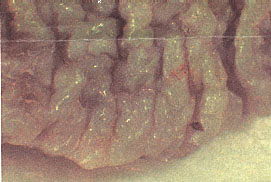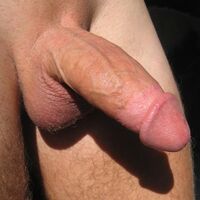Biology:Ridged band

The ridged band is a band of mobile skin at the most distal end of the foreskin. It is part of the akroposthion: the portion which extends beyond the glans. It has, especially in regard to phimosis and preputioplasty, been called the preputial ring or phimotic ring. More particularly, it refers to the transitional area from the external to the internal surface of the prepuce, or foreskin.[1][2][3][4][5] Rich in Meissner's corpuscles,[6] the area is usually described as highly erogenous.[7][8][9]
Along with the frenulum of the penis, it is considered to be the most sensitive part of the penis to fine-touch.[3][4][7][10] It was discovered by Canadian pathologist and medical researcher John Taylor in 1991 and first anatomically and histologically detailed in the British Journal of Urology in 1996.[11] The structure is generally believed to be important in male sexual sensation and reflexes.[3][11][12] Most or all of the ridged band is removed by male circumcision due to its position on the prepuce.[11] Efforts to regenerate the ridged band are presently underway by scientists.[13]
History
Taylor et al. (1996)
Taylor first used the term "ridged band" instead of "wrinkly skin" and described the structure at the Second International Symposium on Circumcision, organized by NOCIRC in San Francisco, 1991, after examining the foreskins of 22 adults obtained at autopsy. The term ridged band was subsequently used by him in an anatomical and histological study of the foreskin published in the British Journal of Urology in 1996. The mean age was 37 years, range 22–58. The prepuces were studied grossly and histologically.[10][11][12]
Foregen regeneration study
In August 2021, the Italian biomedical company Foregen announced that it would be conducting a histological study of the ridged band, along with other parts of the foreskin, in its efforts to regenerate it, the frenulum, and preputial mucosa of the prepuce.[13]
Structure

Taylor described the ridged band as a transversely ridged band of mucosal tissue, located just inside the tip of the foreskin near the mucocutaneous boundary, also known as the preputial sphincter. He characterized the ridged band as intensely vascular and richly innervated, stating that it "contains more Meissner's corpuscles than does the smooth mucosa", and noted that these tactile corpuscles were found only in the crests of ridges.
Function

The prepuce, including the ridged band, is a specific erogenous zone.[14]
Taylor (1996) postulates that "the ridged band with its unique structure, tactile corpuscles and other nerves, is primarily sensory tissue".[11] He hypothesizes (2007) that Meissner's corpuscles in the ridged band are adapted to detect stretch:
- Work in progress indicates that retraction and stretching of this accordion-like structure triggers reflex contraction of bulbocavernosus and bulbospongiosus.[15]
Taylor theorizes that the main function of the ridged band is to trigger sexual reflexes. In a letter to the editor of BJU International, 2007, Taylor writes:
- Initial study (J.R.T. unpublished) indicates that the real importance of the ridged band to sexual intercourse lies in an ability to trigger a reflex contraction of muscles responsible for ejaculation.[16]
In the Journal of Sexual Medicine, 2007, Taylor states:
- Both glans and prepuce contribute to the single mucocutaneous junctional zone of the penis and it is possible that these apparently dissimilar structures in fact share similar functions related more to sexual reflexes than to touch perception.[15]
The effect of circumcision on sexual function is the subject of intense debate. Taylor's view is that "almost certainly, removal of the prepuce and its ridged band distorts penile reflexogenic functions but exactly how and to what extent still remains to be seen".[15] More recent research has demonstrated that the clinically important bulbocavernosus reflex is absent in 73% of circumcised men ostensibly due to the removal of fine-touch nerve endings in the ridged band.[17]
For an overview of the issues surrounding male circumcision and sexual function, see Sexual effects of circumcision.
See also
- Mucocutaneous zone
- Preputial mucosa
- Sexual effects of circumcision
References
- ↑ Kimmel, Michael; Milrod, Christine; Kennedy, Amanda (2014). Cultural Encyclopedia of the Penis. United States: Rowman & Littlefield Publishers. pp. 73. ISBN 978-0759123120.
- ↑ Fahmy, Mohamed (2020). Normal and Abnormal Prepuce. Springer International Publishing. pp. 45. ISBN 9783030376215.
- ↑ 3.0 3.1 3.2 Basu, SC (2011). Male Reproductive Dysfunction. Jaypee Brothers. pp. 74, 78–79. ISBN 9789350252208.
- ↑ 4.0 4.1 Gallo, Luigi (June 2017). "The prevalence of an excessive prepuce and the effects of distal circumcision on premature ejaculation". Arab Journal of Urology 15 (2): 140–147. doi:10.1016/j.aju.2017.02.002. ISSN 2090-598X. PMID 29071143. PMC 5653616. http://dx.doi.org/10.1016/j.aju.2017.02.002.
- ↑ Hemat, R. A. S. (2001). Urotext-Luts: Urology. Urotext. pp. 592. ISBN 9781903737033.
- ↑ García‐Mesa, Yolanda; García‐Piqueras, Jorge; Cobo, Ramón; Martín‐Cruces, José; Suazo, Iván; García‐Suárez, Olivia; Feito, Jorge; Vega, José A. (2021-06-12). "Sensory innervation of the human male prepuce: Meissner's corpuscles predominate". Journal of Anatomy 239 (4): 892–902. doi:10.1111/joa.13481. ISSN 0021-8782. PMID 34120333. PMC 8450466. http://dx.doi.org/10.1111/joa.13481.
- ↑ 7.0 7.1 McMahon, Chris (2012). Premature Ejaculation: From Etiology to Diagnosis and Treatment. Springer Publishing. pp. 168–169. ISBN 9788847026469.
- ↑ Bunker, Chris (2004). Male Genital Skin Disease. Saunders. pp. 18. ISBN 9780702027604.
- ↑ Cox, Guy; Krieger, John N.; Morris, Brian J. (June 2015). "Histological Correlates of Penile Sexual Sensation: Does Circumcision Make a Difference?". Sexual Medicine 3 (2): 76–85. doi:10.1002/sm2.67. ISSN 2050-1161. PMID 26185672. PMC 4498824. http://dx.doi.org/10.1002/sm2.67.
- ↑ 10.0 10.1 Sorrells ML, Snyder JL, Reiss MD, et al. Fine-touch pressure thresholds in the adult penis. BJU Int. 2007;99(4):864–869. doi:10.1111/j.1464-410X.2006.06685.x. PMID 17378847.
- ↑ 11.0 11.1 11.2 11.3 11.4 Taylor JR, Lockwood AP, Taylor, AJ. The prepuce: Specialized mucosa of the penis and its loss to circumcision. British Journal of Urology. 1996;77(2):291–295. doi:10.1046/j.1464-410X.1996.85023.x. PMID 8800902. (Reprint: cirp.org)
- ↑ 12.0 12.1 Glick, Leonard (2005). Marked in Your Flesh: Circumcision from Ancient Judea to Modern America. Oxford University Press. pp. 214. ISBN 9780198039259.
- ↑ 13.0 13.1 Drozd, Tyler (August 11, 2021). "August 2021: Foregen Newsletter". https://www.foregen.org/commentarium-articles/august-11th-2021.
- ↑ Winkelmann RK. The erogenous zones: their nerve supply and significance. Mayo Clin Proc. 1959;34(2):39–47. PMID 13645790.
- ↑ 15.0 15.1 15.2 Taylor JR. The forgotten foreskin and its ridged band (letter). J Sex Med. September 2007;4(5):1516. doi:10.1111/j.1743-6109.2007.00588.x. PMID 17727357.
- ↑ Taylor, JR. Fine-touch pressure thresholds in the adult penis (letter). BJU Int. July 2007;100(1):218. doi:10.1111/j.1464-410X.2007.07026_4.x. PMID 17552969.
- ↑ Podnar S. Clinical elicitation of the penilo-cavernosus reflex in circumcised men. BJU Int. 2012;209:582–5. doi:10.1111/j.1464-410X.2011.10364.x. PMID 21883821.
External links
Sexual health information
Scientific research

